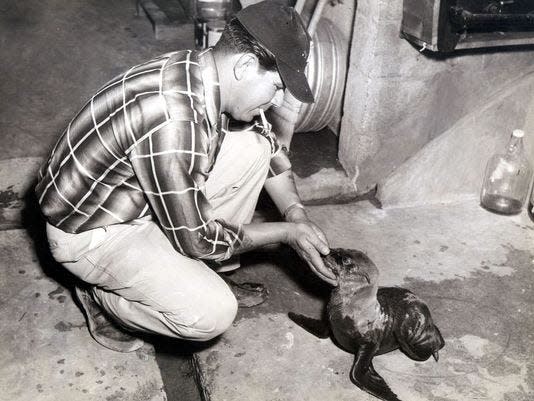'Operation Sea Lion' brings mammals to Washington Park Zoo in 1958
El Paso's first sea lions arrived at the Washington Park Zoo on June 22, 1956.
"Three California sea lions, newest addition to the Washington Park Zoo, refused to eat at their first meal in their new home today.
"City Superintendent of Parks and Recreation Bryce Lammert said, 'They'll eat soon. They just aren't used to their new home. This is the first time they've been out of salt water and they're not accustomed to it.'
"Mr. Lammert tried to feed the animals, but every time he threw them a hunk of fish, they turned and swam away."
More:Memorial Park rededicated as Veterans Memorial Park in 1969 to honor all who served
Arrived in boxes
"The pool is four feet deep, 30 feet wide and 40 feet long. Behind it is a 'rock' shelter made of gunite (sprayed concrete). The shelter has several flower beds. The back of the shelter will be used as part of the prairie dog exhibit, to be installed soon.
"Mr. Lammert said the sea lions, all males, arrived last night from California. They came in boxes with cakes of ice on top, which dripped and kept them wet. The sea lions cost $125 each. He estimated the total cost of the exhibit at around $6,000."
In May 1958, Lammert launched "Operation Sea Lion." He organized a group of park workers and chartered a boat into the Gulf of California to hunt for sea lions.
Lammert was quoted as saying, "Sea lions are quite expensive when you buy them. We hope to save money by catching eight or 10 baby sea lions for the Washington Park Zoo. Then El Pasoans can watch them grow."

Brought two seals back
Unfortunately, they planned their trip about a month late and Lammert dislocated his shoulder, but the group managed to bring two seals back to El Paso.
Reported May 21, 1958: "The two sea lions brought back from the Gulf of California Sunday are reported adjusting to the seal pond at Washington Park Zoo. The larger of the two has been placed in the pond with the sea lion already at the zoo and Bryce Lammert, Parks Superintendent, says they're becoming fast friends."
Less than a week later, on May 27: "Jorge, baby sea lion at Washington Park zoo, has died.
"The animal, in good health until Friday, lost two ounces on that day and died Saturday. He had been fed with a bottle."
More:‘Flying Saucer’ Sighting Reported By Eight Crosby School Students: Trish Long
Stranded 18 hours
A June 1959 expedition didn't go much better. Three men from the group were stranded for 18 hours when the batteries went out on their motorboat.
After being rescued, the group returned with one baby sea lion. This prompted one taxpayer to ask why the city would spend $241 on the expedition when a sea lion could be purchased for $125.
Lammert replied, "That's right. But we had hoped to bring back six adult sea lions, which would have made them cheaper. It's like going fishing; sometimes you don't catch anything."
However, the publicity over the trip prompted the Rio Grande Zoo in Albuquerque to offer a 2-year-old sea lion to the Washington Park Zoo as a gift.
As it stood then, the zoo had two adult sea lions ‒ George and Georgette ‒ and the new baby brought back by the expedition. The Albuquerque sea lion would make four.
Baby sea lion dies
Three weeks later, Lammert announced the baby sea lion had died at the zoo. He said it had been in poor health, and speculated that it had pneumonia.
On Dec. 28, 1960, Lammert said two new sea lions were ordered to replace the two that had died.
"Georgette, the female sea lion, died Sunday. The male died several weeks ago. They were a major attraction at the zoo.
"The sea lions suffered from respiratory trouble of some kind, Mr. Lammert said."
Sugar and Spice added
On June 8, 1962, sea lions Sugar and Spice were added to the zoo pool.
"The two sea lions swam happily in the sea lion pool at the zoo after being out of water for nearly 12 hours.
"They arrived early today at the airport where they were met by Park Department officials.
"Zoo officials soaked the sea lions with hoses after their arrival in El Paso and took them to the pool about midmorning.
" 'Sea lions are air breathers, but if they are kept out of the water for a long time, their skin will dry out,' Mr. (Max) Blassingame (assistant superintendent of parks) said.
"The sea lions, one male and one female, are described by Mr. Blassingame as 'young adults.' That means they are about 18 months old.
"Already a resident at the sea lion pool is Suzie, an 'adult' at two and a half years. Suzie's partner died about two months ago of something like pneumonia, Mr. Blassingame said."
On Feb. 20, 1964, it was announced that Cindy the sea lion was added to the pool to keep Spicy company since Sugar had died seven months earlier.
Lonely days are over
By February 1971, it was Susie and newly arrived Connie.
"Lonely days are all over for Susie, the El Paso Zoological Garden's sea lion. Thanks to kind-hearted El Pasoans, she now has a playmate, Connie, a new arrival at the zoo.
"Problems started for Susie when the zoo's other sea lion died recently of nephritis and old age.
"Deprived of her friend, Susie began refusing food and moping."
Trish Long may be reached at tlong@elpasotimes.com or 915-546-6179.
This article originally appeared on El Paso Times: 'Operation Sea lion' brings mammals to Washington Park Zoo in 1958
